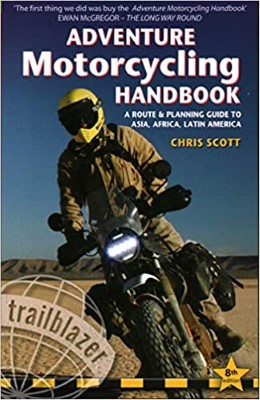 8Likes 8Likes
 |

11 Apr 2021
|
|
Registered Users
HUBB regular
|
|
Join Date: Dec 2018
Location: Kincardine, ON, Canada
Posts: 37
|
|
|
How to protect your gear from turning black from Aluminum?
I have an aluminum top box, anything you put inside it gets blackened from the bare aluminum.
My attempts:
-Lined the inside with a self adhesive clear poly film which was about 6mil thick. This works but the the film wears through quickly from items bouncing in the box and didn't last.
-Spray painted a rubberized coating that is used for automotive applications. As with the film liner, it wears quickly and has started to peel where it has worn.
-My goto is an old helmet bag, I put items inside the bag to protect them and not worry about the bag. This works but you can't find things as quickly if they were just in the box.
Anyone have luck with a particular product to coat the inside of an aluminum box or pannier?
thanks
brian
|

11 Apr 2021
|
|
Registered Users
HUBB regular
|
|
Join Date: Jan 2013
Posts: 65
|
|
|
Maybe try a cheap closed-cell foam sleeping mat that you can get for a few bucks? Cut a bottom and a long piece that you use to line the walls. It's soft and chushioning, should do the trick!
|

11 Apr 2021
|
|
Contributing Member
Veteran HUBBer
|
|
Join Date: Sep 2018
Location: Belper, uk, EUROPE
Posts: 575
|
|
|
Are you able to get it powder coated in a clear lacquer? If there are no plastic parts it should be doable - you may have to mask off certain parts. Beware of trying to powder coat over paint - it really doesn’t work and if you have any doubts then use a spray lacquer coating.
__________________
You will have to do without pocket handkerchiefs, and a great many other things, before we reach our journey's end, Bilbo Baggins. You were born to the rolling hills and little rivers of the Shire, but home is now behind you. The world is ahead.
|

12 Apr 2021
|
|
Registered Users
Veteran HUBBer
|
|
Join Date: Sep 2007
Location: Oslo, Norway
Posts: 164
|
|
|
Lining aluminium panniers
I solved this problem by using thin strong mat, sold for car interiors. Cut to required shape and glued in place. make cut-outs for bolts. For the bottom I used a removable piece of an old sleeping mat on one side. The other bottom I used a thin plywood, with a finger hole, covered with a bit of car mat. this makes a false bottom, which has proved very useful for hiding that which must remain hidden. The whole job was much less hassle than you would think, and has worked very well.
Peter, in Oslo, and it's snowing today
|

12 Apr 2021
|
|
Registered Users
HUBB regular
|
|
Join Date: Dec 2018
Location: Kincardine, ON, Canada
Posts: 37
|
|
|
Great ideas. thank you all. I never considered making a false bottom, I can see it being useful.
thanks
brian
|

13 Apr 2021
|
|
Contributing Member
Veteran HUBBer
|
|
Join Date: Sep 2018
Location: Belper, uk, EUROPE
Posts: 575
|
|
|
If you are gluing a false bottom in or spraying a clear lacquer or powder coating it then preparation is key - sorry, I couldn't resist the pun - and that means ensuring that the surface is grease and dust free - the results will last longer and will look better.
Alternatively use a bin bag or make some pannier liners with handles - these will also make unloading at a hotel / hostel a lot quicker and will reduce any issues if there is a slight leak in the pannier. Liners look a lot classier at reception than bin bags though!
__________________
You will have to do without pocket handkerchiefs, and a great many other things, before we reach our journey's end, Bilbo Baggins. You were born to the rolling hills and little rivers of the Shire, but home is now behind you. The world is ahead.
|
|
Currently Active Users Viewing This Thread: 1 (0 Registered Users and/or Members and 1 guests)
|
|
|
 Posting Rules
Posting Rules
|
You may not post new threads
You may not post replies
You may not post attachments
You may not edit your posts
HTML code is Off
|
|
|
|

Check the RAW segments; Grant, your HU host is on every month!
Episodes below to listen to while you, err, pretend to do something or other...

2020 Edition of Chris Scott's Adventure Motorcycling Handbook.
"Ultimate global guide for red-blooded bikers planning overseas exploration. Covers choice & preparation of best bike, shipping overseas, baggage design, riding techniques, travel health, visas, documentation, safety and useful addresses." Recommended. (Grant)

Led by special operations veterans, Stanford Medicine affiliated physicians, paramedics and other travel experts, Ripcord is perfect for adventure seekers, climbers, skiers, sports enthusiasts, hunters, international travelers, humanitarian efforts, expeditions and more.
Ripcord Rescue Travel Insurance™ combines into a single integrated program the best evacuation and rescue with the premier travel insurance coverages designed for adventurers and travel is covered on motorcycles of all sizes.
(ONLY US RESIDENTS and currently has a limit of 60 days.)
Ripcord Evacuation Insurance is available for ALL nationalities.
What others say about HU...
"This site is the BIBLE for international bike travelers." Greg, Australia
"Thank you! The web site, The travels, The insight, The inspiration, Everything, just thanks." Colin, UK
"My friend and I are planning a trip from Singapore to England... We found (the HU) site invaluable as an aid to planning and have based a lot of our purchases (bikes, riding gear, etc.) on what we have learned from this site." Phil, Australia
"I for one always had an adventurous spirit, but you and Susan lit the fire for my trip and I'll be forever grateful for what you two do to inspire others to just do it." Brent, USA
"Your website is a mecca of valuable information and the (video) series is informative, entertaining, and inspiring!" Jennifer, Canada
"Your worldwide organisation and events are the Go To places to for all serious touring and aspiring touring bikers." Trevor, South Africa
"This is the answer to all my questions." Haydn, Australia
"Keep going the excellent work you are doing for Horizons Unlimited - I love it!" Thomas, Germany
Lots more comments here!

Every book a diary
Every chapter a day
Every day a journey
Refreshingly honest and compelling tales: the hights and lows of a life on the road. Solo, unsupported, budget journeys of discovery.
Authentic, engaging and evocative travel memoirs, overland, around the world and through life.
All 8 books available from the author or as eBooks and audio books
Back Road Map Books and Backroad GPS Maps for all of Canada - a must have!
New to Horizons Unlimited?
New to motorcycle travelling? New to the HU site? Confused? Too many options? It's really very simple - just 4 easy steps!
Horizons Unlimited was founded in 1997 by Grant and Susan Johnson following their journey around the world on a BMW R80G/S.
 Read more about Grant & Susan's story
Read more about Grant & Susan's story
Membership - help keep us going!
Horizons Unlimited is not a big multi-national company, just two people who love motorcycle travel and have grown what started as a hobby in 1997 into a full time job (usually 8-10 hours per day and 7 days a week) and a labour of love. To keep it going and a roof over our heads, we run events all over the world with the help of volunteers; we sell inspirational and informative DVDs; we have a few selected advertisers; and we make a small amount from memberships.
You don't have to be a Member to come to an HU meeting, access the website, or ask questions on the HUBB. What you get for your membership contribution is our sincere gratitude, good karma and knowing that you're helping to keep the motorcycle travel dream alive. Contributing Members and Gold Members do get additional features on the HUBB. Here's a list of all the Member benefits on the HUBB.
|
|
|